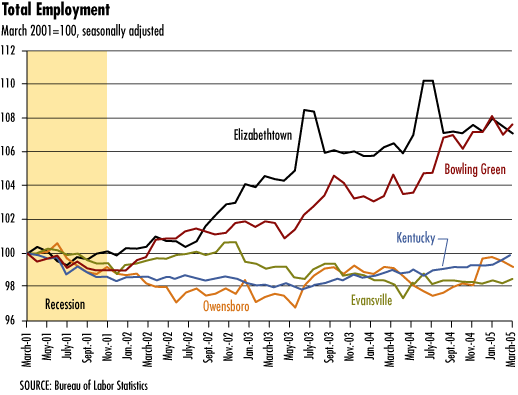District Overview: Neighboring Cities Show Job Trends That Are Far Apart
Employment trends in the metropolitan statistical areas (MSAs) of Bowling Green, Elizabethtown, Owensboro and Evansville have been far from uniform. Although employment in all four neighboring MSAs fell during the recent recession, which began in March 2001 and ended the following November, only two have seen a significant recovery since then. As seen in the chart, Bowling Green and Elizabethtown have greatly outperformed Kentucky as a whole in terms of employment growth since the end of the recession. But Owensboro and Evansville have been more similar to the state of Kentucky as a whole.
Bowling Green's employment decreased by 1 percent during the recession, then rebounded to its prerecession level by March 2002. Strong growth since that time has resulted in April 2005 employment that was 7.6 percent higher than it was in March 2001.
Bowling Green's recovery was bolstered by postrecession increases in employment in the professional and business services sector and in the leisure and hospitality sector, which rose by 34 percent and 22 percent, respectively, from November 2001 through April 2005. Natural resources, mining and construction employment increased by 7 percent from April 2004 to April 2005. Job growth in the manufacturing sector has been showing improvement since late 2003.
After experiencing a relatively mild recession, Elizabethtown has seen nearly continuous job growth. After falling 0.7 percent between March 2001 and July 2001, employment returned to its prerecession level by October 2001. As of April 2005, employment was 7 percent higher than in March 2001.
Elizabethtown actually experienced an increase in employment during the recession. Between March 2001 and November 2001, professional and business services employment increased by nearly 15 percent, while natural resources, mining and construction employment increased by more than 10 percent. The largest employment decline over the same period was a 4 percent decrease in manufacturing. April 2005 employment numbers for all major sectors except manufacturing were above November 2001 levels. Professional and business employment in April 2005 was 45 percent higher than in November 2001. Over this same period, education and health services employment rose by 13 percent, and employment in trade, transportation and utilities grew by 8 percent.
Employment in Owensboro increased by 0.3 percent between March 2001 and June 2001 but decreased by 1.4 percent between June 2001 and the end of the recession. Employment continued to fall through June 2003, reaching a level that was 3 percent below March 2001 employment. Employment began to trend upward in July 2003, but employment in April 2005 was still 1 percent lower than prerecession levels.
Owensboro had its largest employment losses in the manufacturing sector and in the trade, transportation and utilities sector, where losses were 4.5 percent and 2.5 percent, respectively, between March and November 2001. Employment in these sectors continued to decline even after the recession. In April 2005, total employment in Owensboro was near its prerecession level due to job growth in financial activities, education and health services, leisure and hospitality, and government.
The Evansville MSA experienced a 0.6 percent decrease in employment during the recession but recovered these losses by July 2002. Since that time, however, employment has trended downward; in April 2005, employment was nearly 2 percent below its prerecession level.
The sector that experienced the largest percent decrease in jobs during the recession was financial services (15 percent). Unlike the other MSAs, there has been very little increase in this or other employment sectors since November 2001. Between November 2001 and April 2005, employment in construction fell by 13 percent, professional and business services employment decreased by 7 percent, and employment in the information and in the financial services sectors fell by 9 and 8 percent, respectively. However, between November 2001 and April 2005, employment in education and health services increased by nearly 1 percent, and leisure and hospitality employment increased by 5 percent.
Views expressed in Regional Economist are not necessarily those of the St. Louis Fed or Federal Reserve System.
For the latest insights from our economists and other St. Louis Fed experts, visit On the Economy and subscribe.
Email Us


